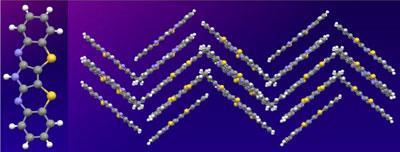New tricks for an old organic semiconductor
An easy-to-make compound first discovered around 40 years ago could find useful roles in making flexible computer chips of the future, according to researchers in China.
Semiconductors made from synthetic organic materials are an attractive alternative to silicon as they offer flexibility and simple manufacturing processes. They are already finding uses in ’all-organic’ LCD screens that can be rolled up into cylinders - but there are still problems with their stability and performance.
Now, a team based at the Chinese Academy of Sciences in Beijing have designed organic transistors based on pyrrolobisbenzothiazine (PBBTZ), a compound first synthesised around forty years ago. The team found that it offered greater stability and comparable properties to conventionally used pentacene.
One problem with pentacene is that it is susceptible to undergoing Diels-Alder reactions with ambient oxygen, resulting in the material degrading over time. To avoid this, the team investigated alternatives with related structures but that would not undergo this reaction.

’In organic semiconductors, pi-orbital overlapping between adjacent molecules forms the path that electrical charge travels through, so well-ordered molecular packing gives better performance,’ explains Wei Xu, who worked on the project. The team reasoned that the central pyrrole unit of PBBTZ resembled pentacene, and was flat enough to give comparable properties.
By studying single crystals, Xu’s team found that found that PBBTZ aligns with a face-to-face arrangement, which gives stronger pi-orbital interactions than the edge-to-face arrangement seen in pentacene. Importantly, PBBTZ has great potential to be further functionalised to boost properties even more. An added benefit is that it can be made in a single step from readily available starting materials.
The team believe this compound warrants further investigation and plan to continue investigating devices made with this material.
Zhenan Bao, an expert in organic electronics at Stanford University, California, US, agrees that this compound shows good potential. ’This is an interesting new material and reflects the great interest in this area at the moment,’ Bao says.
Lewis Brindley
Enjoy this story? Spread the word using the ’tools’ menu on the left.
Link to journal article
]bis[1,4]benzothiazines: facilely synthesized semiconductors for organic field-effect transistorsWei Hong, Zhongming Wei, Hongxia Xi, Wei Xu, Wenping Hu, Quanrui Wang and Daoben Zhu,?
J. Mater. Chem., 2008,
18, 4814
DOI:10.1039/b809486a






No comments yet